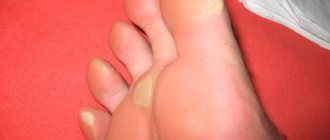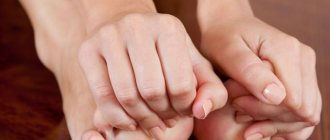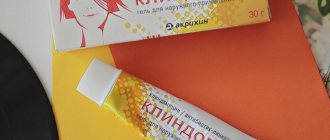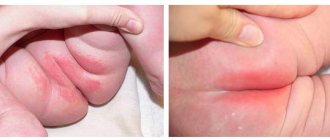What it is?
There are two types of calluses:
- callus (appears with prolonged friction or pressure on the skin of the feet);
- callus (formed during the process of bone tissue regeneration after fractures, is a connecting “layer” that is formed at the site of a violation of the integrity of bone tissue).
Important! Of great interest to most people, of course, is callus, which forms when wearing uncomfortable shoes, having flat feet, excess weight, problems with joints, etc.
Causes of watery calluses
A water callus on the toe, heel, or foot occurs as a result of wearing tight shoes.
Most often, traumatic friction on the surface of the skin is created by decorative membranes, toes, heels or hard elements of new shoes. The occurrence of water callus is promoted by:
- tight shoes;
- sweaty feet;
- swelling of the limbs;
- shoes made of artificial materials;
- sand or other abrasives on the surface of the skin.
The mechanism of formation of water calluses
As a result of pressure or friction on the surface of the skin, redness, swelling and peeling of the epidermis occurs. The resulting cavity (bubble) is quickly filled with intercellular fluid. The occurrence of dropsy is a physiological process of protecting the body from the penetration of staphylococcal or streptococcal infections into injured skin.
At the slightest touch or pressure, the water callus causes significant pain. If friction against the surface of the skin continues, the filled bubble bursts, leaving a red, weeping wound on the inflamed area.
Signs of water blisters infection:
- temperature increase;
- purulent discharge from the callus;
- expansion of the boundaries of redness;
- change in color of water callus;
- the appearance of yellow flaky areas around the callus;
- pain in the inflamed area even without mechanical impact.
Kinds
All skin growths can be divided into several subtypes:
- wet (watery, soft);
- dry (hard);
- rod;
- corns.
Wet seals on toes and heels
Watery calluses are fluid-filled blisters. The shell of such vesicles is the top layer of the skin. The liquid inside the growth can be either clear or yellowish.
Attention! Sometimes the filling of the callus has a reddish tint. This means that the capillary was affected during the process of friction and defect formation.
It is watery growths that cause particular discomfort and pain when walking or any pressure on the foot. Quite often, further prolonged traumatic impact on such a compaction leads to its transformation into a hard form of callus.
Dry formations
Hard calluses are formed as a result of prolonged friction or exposure to the skin of the foot. This is not so much a type of callus as one of the stages of its development (follows the appearance of soft defects).
Reference. Sometimes a dry growth can skip the watery stage and immediately form a keratinized layer of skin at the site of damage.
This omission occurs when constant pressure with slight friction is applied to the skin. This allows the callus to form gradually. Such a growth can occur not only on the foot, but also on the fingers, elbows, knees, etc.
Corns
This is a subtype of dry calluses. The difference is that corns cover a larger area of skin, do not have clear boundaries, and the place of their formation is always the feet.
Important! Often, corns can have rods that cause pain in the feet.
Rod growths
Often such defects occur in the areas between the toes, as well as on the feet and heels. The peculiarity of such growths is that, in addition to the callus itself, they also contain a core deepened into the skin. It is this core that brings significant discomfort to the wearer, and it is because of it that this type of callus is so difficult to remove.
Attention! If such a core callus is not removed in a timely manner, then over time it will begin to cause noticeable pain to the wearer, as well as cause the appearance of microcracks on the foot and provoke infection.
Choosing the right shoes
By the end of the day, feet often swell, actually increasing by 0.5 -1 size, so it is better to buy new shoes in the evening. Shoes should not squeeze the foot, but should not dangle loosely on it. It is important to remember that the size may vary on different feet, so you need to try on shoes on both feet at once. You need to walk a little in new shoes. In order to understand that these shoes suit you and will not rub when you walk, you don’t have to walk around the store in them for half a day. Walking for two to three minutes is enough. If during this time you realized that your legs are not entirely comfortable, it is better to pay attention to another model, even if you liked the previous pair more. Even if you choose shoes that you will wear from time to time, for example, when going out, comfort is still an important criterion when choosing. What good are new boots if they end up collecting dust in the closet? Well, you need to pay maximum attention to the choice of shoes that you plan to wear every day.
Right size
Shoes should be neither larger nor smaller than your size. Before purchasing, measure your foot in centimeters and check the manufacturer’s sizing chart.
Hard ass
When purchasing, pay attention to the heel of the shoe. A hard heel is more common in patent leather shoes, as well as products made from artificial materials. The heel should hold its shape well, but not put too much pressure on the heel. There should be no rough parts or seams on it, otherwise this will inevitably lead to the appearance of calluses.
Poor quality material
Natural materials such as leather and suede provide not only a presentable appearance, but also guaranteed comfort and safety for your feet. Shoes made from natural materials tend to wear out and take the shape of the foot, taking into account its characteristics. If it is chosen correctly, the discomfort that may be present at the beginning will disappear over time. The shoes adapt to the anatomy of the foot and become comfortable. Artificial material does not have the ability to expand and change. If such shoes rub at the very beginning, nothing will change later during wear.
Excessive sweating
Excessive sweating of the feet is often the cause of calluses. Even if the size is chosen correctly, excess moisture contributes to skin injury. You can apply a little talcum powder to the skin of your feet and the heel of your shoes before going out, this will help cope with heavy sweating.
Heel bend - a feature that not everyone knows about
You will be surprised, but all people have different heel structures. The degree of bending is individual for everyone, it is important to take this into account when choosing a new pair. There are 2 types of bending: smooth and active .
A smooth bend will be closer to a right angle. Active - on the contrary, strive for something spicy. When choosing the model you like, pay attention to whether the heel of the shoe suits the structure of your heel. After all, if the lines of the corners on the heel of the shoe do not correspond to the line of your heel, such shoes will certainly rub. It is necessary that the foot sticks to the heel of the shoe as much as possible, this will ensure wearing comfort and avoid the appearance of calluses. Surely, like many, you had no idea about all these intricacies, and perhaps a pair of shoes that rub your heel is already collecting dust in your closet. Don't rush to get rid of it! There is a chance to return it to your wardrobe.
Why do they appear?
There are several indirect reasons for the appearance of such defects:
- difficulty walking in high heels or uncomfortable shoes;
- open seams inside the boots that the foot can rub against;
- disproportionate socks that can wrinkle while walking;
- excessive load on the lower limbs (may be associated with excess weight, problems with the spine, heavy clothing, bags and other burdens);
- predisposition of the skin to the formation of keratinized areas;
- psoriasis;
- flat feet;
- diabetes;
- hypovitaminosis (lack of vitamin A);
- the specifics of physical activity (may be related to profession, sports activities, housekeeping, etc.).
What to do with a wet look and what ointment to apply?
The choice of therapeutic course will depend on the type of growth.
If the neoplasm is still at the initial stage of development and is a small bubble with liquid inside, then it will go away on its own. All you can do at this stage is cover it with a band-aid and avoid wearing shoes, which could make the situation worse. But when the growth has reached an impressive size, it’s time to give your legs proper care:
- The entire erased area and the damage itself must be treated with a solution of brilliant green or iodine.
- Disinfect a needle or pin and pierce the bubble with the liquid accumulated inside.
Reference. The puncture should be made parallel to the surface of the epidermis on the side of the callus. It is impossible to make perpendicular injections, since it can damage healthy areas of the skin under the bubble. - If the liquid flows poorly, then make several punctures.
- The walls of the callus should remain intact, there should be no breaks.
- After all the liquid has come out, you need to treat the callus with a sterile napkin and blot off any remaining exudate.
- Then the entire surface is treated with hydrogen peroxide or furatsilin, a thick layer of antibacterial ointment is applied, a small piece of bandage is applied on top and a patch is applied.
Next, you can watch a video about what to do when a wet callus appears:
How to treat a hard growth so that it does not exist?
If the rubbing process was long and the growth became dense and dry, then be prepared for the treatment to be delayed. It is imperative to use special softening preparations that will help remove rough layers of skin.
Salicylic acid
Salicylic acid is a standard ingredient that helps soften hard growths on the feet. It is included in many creams, ointments, gels and even patches (“Namozol”, “Kollomak”, etc.).
Before using products with salicylic acid, you should steam your feet and stick a patch with the middle cut out on the problem area (the hole should be the size of a callus). Only after this the drug can be applied to the growth. You can use acid 1-2 times a day.
Lactic acid
Important! Lactic acid is a less aggressive agent compared to salicylic acid.
Such preparations (“Green Pharmacy”, “Super Anticorn”, etc.) should be applied in a thick layer to the injury and covered with a bandage. After a couple of hours, you can remove the softened defect with a spatula, and rinse off the remaining product with water.
Treatment with celandine
A universal plant that is actively used in folk medicine. Excellent against corns and warts. You need to use a solution based on celandine twice a day, but the treatment course should not last longer than 10 days. Burn the damaged areas for 8–10 minutes, and then rinse off the product with warm water. You can also use pharmaceutical preparations based on celandine (“Call Ka”, “Stopmozol”).
Sodium hydroxide
Preparations based on sodium hydroxide are quite aggressive, and therefore they quickly corrode dead skin cells, removing calluses. Such drugs (“Antipapillom”, etc.) must be used extremely carefully so as not to harm healthy areas of the skin.
Phenol
Products containing phenol help to burn and mummify rough areas of the skin. Gradually the callus will dry out and fall off on its own.
Attention! The most commonly used drugs are “Verrukacid”, “Vartek” and others.
Refrigerants
Such drugs have only recently begun to gain popularity. They help get rid of growths in the shortest possible time. Using a special applicator, the product is applied to rough areas of the skin. A bubble with liquid forms at the site of damage. Healthy tissues remain safe and sound, but the bubble gradually dries out and falls off. This category of drugs includes “Wartner” and “Cryopharm”.
How to treat a sore area using traditional methods?
Folk remedies in combination with conservative therapy work well against all types of calluses:
- Lemon juice. Lemon juice works well for dry calluses. Apply a slice of fresh lemon to the keratinized skin of the growth, secure with a band-aid, and the next morning remove and remove the defect.
- Oat straw. Prepare a decoction of oat straw in proportions of 1:10. Take hot baths with this decoction every day (15 minutes each). Immediately after such procedures, remove rough calluses.
- Dandelion juice. Every day you need to lubricate the damage with dandelion juice, which can be squeezed from the flowers or stems. You need to repeat the procedure until the calluses completely disappear.
- Meadow geranium. Meadow geranium poultices work well against minor defects. Daily procedures will help you forget about calluses in just a couple of weeks.
- Vinegar and chicken egg. Pour 80% vinegar into a glass and place a fresh chicken egg in it. After 7–8 days it should completely dissolve in this solution. Apply the resulting mixture to the sore spot and bandage it. If you feel pain, you should immediately remove the bandage and rinse off any remaining product under running water.
How to avoid: preventive measures
In order to avoid the appearance of calluses of any kind, you should listen to some recommendations:
- choose shoes by size;
- try not to get carried away with wearing high-heeled shoes;
- if you feel pain or severe discomfort, stop wearing such shoes or protect your feet from rubbing;
- choose only high-quality shoes with a comfortable and soft last;
- Treat all calluses and cracks that form in a timely manner.
Why new shoes rub your heel, and what to do to avoid mistakes when buying
There are many reasons for this problem. It is important to know the basics in order to avoid problems when purchasing.
- The size is incorrect.
- The model is not right for you, since everyone has different fullness and width of the foot, as well as a different curvature of the heel.
- The back of the shoe is too hard.
- Poor quality material, rough seams.
- Excessive sweating of the feet.
pixabay
Is it possible to break in new shoes in an hour?
Reference. No matter how many people would like to, it’s impossible to break in new shoes in an hour, two or even three. Breaking in shoes should be gradual. It can take from several days to several weeks (it all depends on the quality and model of the shoes).
To make the process a little easier, you can lubricate the areas where your shoes especially rub with vodka or alcohol, then put on your shoes and walk in them for 10–15 minutes. Repeat the procedure daily.
You can also purchase a special cream or foam for stretching shoes (most often they work on leather or leatherette). If certain areas of your boots rub, lubricate them with wax, castor oil or soap.
From the video below you can learn how to quickly break in new shoes:
New shoes rub on the back: what to do about them?
So. Shoes or boots have been purchased, but there is a suspicion that they will rub your feet when worn. Or they have already shown themselves not to be their best.
pixabay
A few tips from a shoemaker to help make your shoes more comfortable:
- You can put on shoes with a thick or woolen sock and walk around in them for 1-2 hours.
- To expand the product, you need to moisten a cloth or napkin with alcohol and wipe the inside of the heel of the shoe (be careful so that the alcohol does not get on the outside of the shoe), then put it on cotton socks and walk around the house. After treating with alcohol, the heel of the shoe can be kneaded with your fingers.
- Castor oil also has a softening effect. They also need to wipe the inside of the heel.
- Wet a napkin, place it on the inside of the backdrop and gently beat with a hammer. This option is not suitable for a product made of varnish; it can be damaged by mechanical stress.
- You can use pliers instead of a hammer. To do this, you need to wrap the heel of the boot on both sides with fabric and wrinkle it. Here you also need to be careful not to damage the product.
- For suede shoes, rubbing the inner surface with beer is suitable. After this, you can also stretch the heel with your fingers and walk around in the shoes for a while.
- Vinegar has worked well for softening shoes. You need to moisten a piece of cloth, push it inside the shoe and leave it overnight.
- Wax, soap or paraffin is also used to rub the backdrop to make it softer.
- Let's remember physics: pour water into a sealed bag, close it and place it in your shoes. Place the shoes with bags inside in the freezer. When water freezes, it will expand and put pressure on the walls, which will cause the inside of the shoe to stretch.
However, using folk remedies, there is a risk of spoiling or deforming the material. This will be especially offensive if the shoes are expensive. To solve this problem, shoe stores sell special aerosol products that will help stretch or soften the hard backs of shoes. Also, in the store you can purchase heel pads in advance, which are glued to the heel in areas of possible chafing. And at the pharmacy you can buy a special pencil against calluses. It contains emollient and antiseptic components. They need to treat the skin of the heel in the area where chafing is most likely.
- Author: Ekaterina Kozhevnikova










